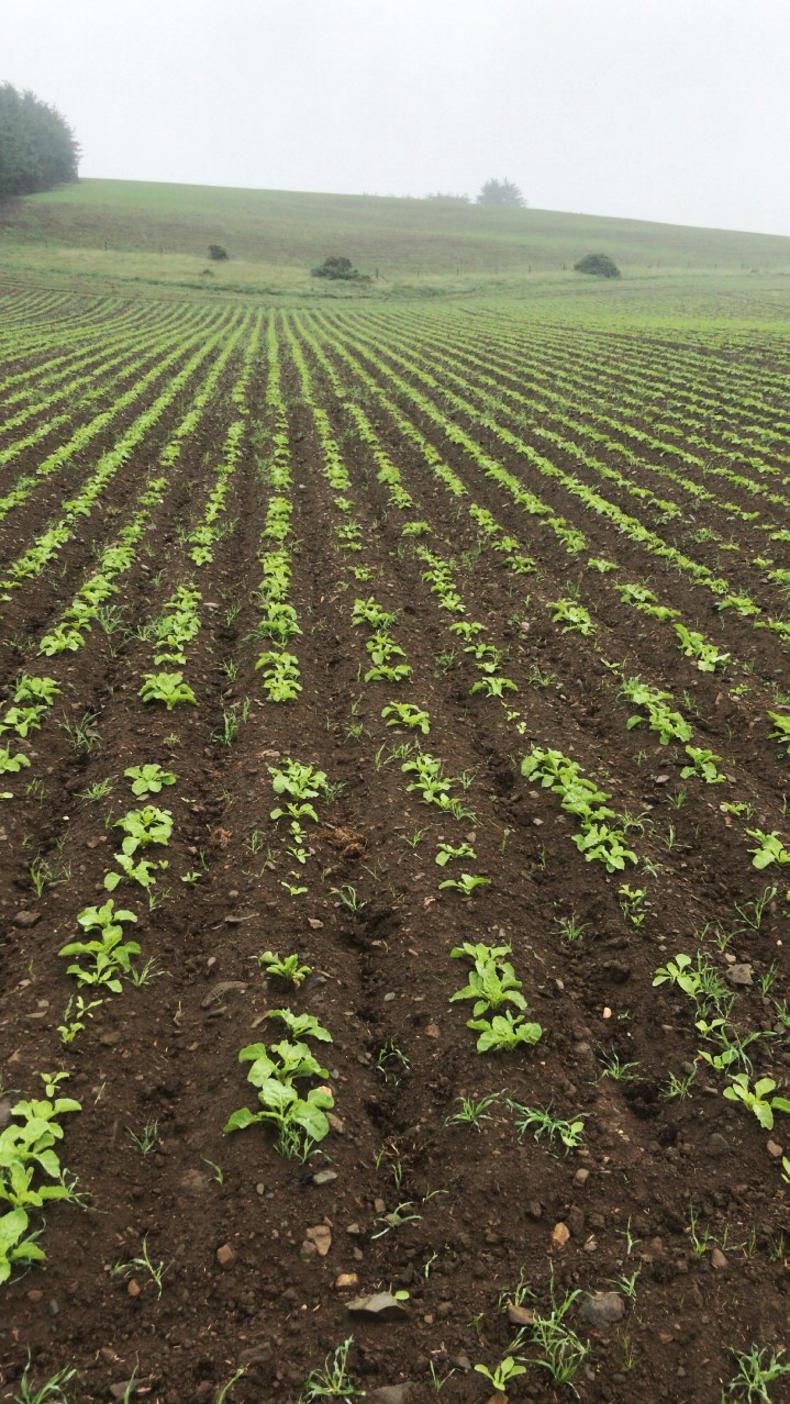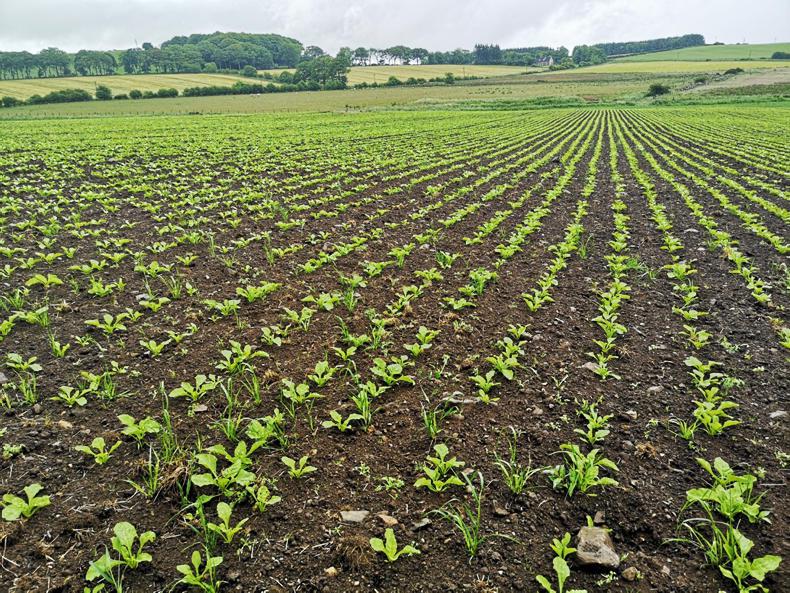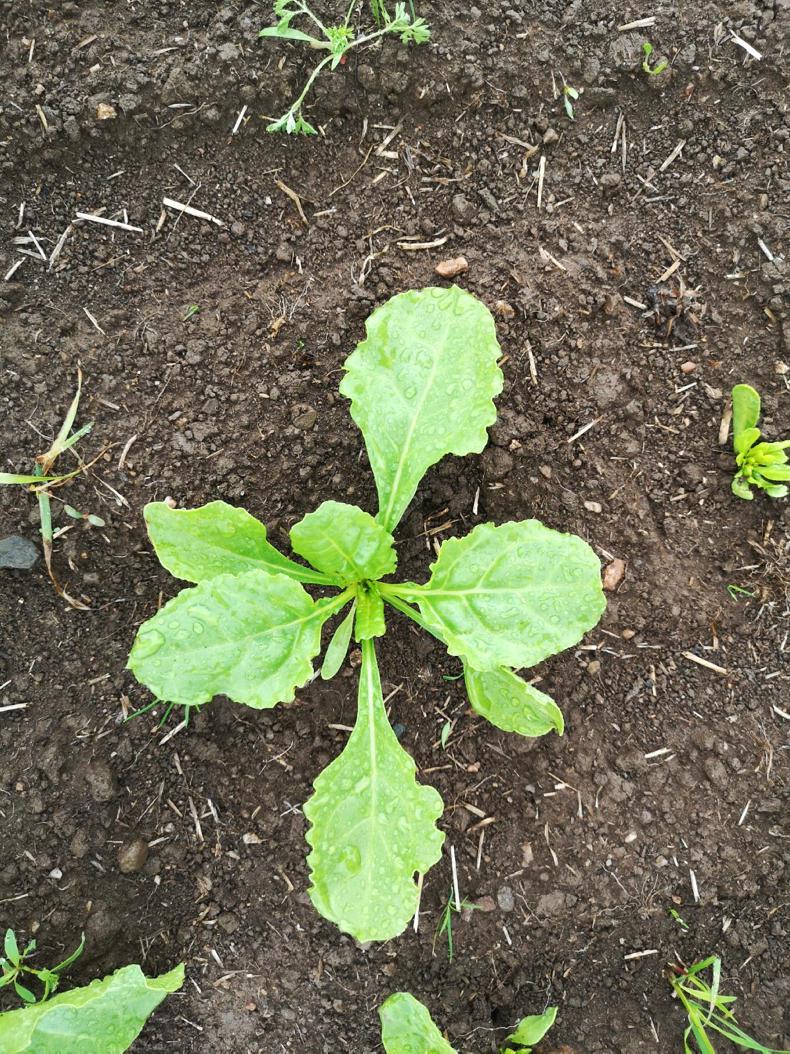Fodder beet is once again becoming an increasingly popular crop in Scotland. In 2019, 971 hectares were grown, a rise of 33% on the year, according to the Scottish Agricultural census.
There are now more hectares of fodder beet grown in Scotland than maize. However, there are twice as many hectares planted in livestock-grade kale and cabbage than fodder beet.
Meanwhile, turnips remain the most popular winter fodder crop, with 3,824ha grown in 2019. This has been a similar area for the last few years after falling from over 5,400ha 10 years ago.
Winter rape is the second most popular winter feed crop with over 2,000ha grown.

This is the Duguid’s fodder beet at Mains of Cranna in Aberchirder. The Farm Profit Programme farmers planted the variety Bangor on the 7th May with 500kg per hectare of turnip fertilizer along with agricultural salt.
In total, Scotland grows around 17,000ha of winter fodder crop down from around 22,000ha 10 years ago.
In comparison, there is 180,000ha of grass under five years old in Scotland and 1.1m hectares of grass five years old or more. Rough grazing accounts for the biggest area of land with over 3m hectares of land in this classification.
Costs
The crop of fodder beet grown at Arnage last year had the following costs:
At a cost of £51 per tonne of dry matter, this is very competitive in comparison to silage and straw.

This is Andrew Biffen’s fodder beet at Arnage by Ellon in Aberdeenshire. Andrew picked Robbos and Kyros varieties which were sold on the 16 of May.
Feeding dry cows on fodder beet before calving is a cheap way of getting through winter. Using the figures above, and assuming each cow will eat around eight kilos of dry matter a day, it will cost 41p/cow/day.
The diet will also need to include 4kg of DM from silage which at a cost of £100/tDM gives an additional cost of 40p/cow/day. This makes the total diet 81p/cow/day for cattle during winter.
In comparison to an indoor diet at around £1/cow/day, coupled with bedding costs of 20p/cow/day, this results in a cost saving of 40p/cow/day. Taking this over a 100-day winter on beet, this is a saving of £40/cow.
When looking at the quantity of silage, the 4kg of dry matter equates to around 100 bales of silage for feeding 50 cows for 100 days on fodder beet.

The Biffens treated the crop with a Pre emergence called Goldtex followed by Bethanol max as post emergence.
While the fodder beet is a fantastic crop to carry dry cows through the winter, care must be taken pre-calving. Ideally, cows should be moved off the forage crop six weeks pre calving to get them set up for calving.
Forage crops
The focus farmers are also going to be establishing further forage crops again this year, with hybrid brassicas being established in to sprayed-off permanent pasture at Cranna for wintering the cows on again this year. Several others are intending to establish the same crop into stubbles post-harvest to carry both ewes and cows.
Forage crops have been a fantastic tool to manage winter costs on the farms and are now forming the core of their winter plans.
Fodder beet is once again becoming an increasingly popular crop in Scotland. In 2019, 971 hectares were grown, a rise of 33% on the year, according to the Scottish Agricultural census.
There are now more hectares of fodder beet grown in Scotland than maize. However, there are twice as many hectares planted in livestock-grade kale and cabbage than fodder beet.
Meanwhile, turnips remain the most popular winter fodder crop, with 3,824ha grown in 2019. This has been a similar area for the last few years after falling from over 5,400ha 10 years ago.
Winter rape is the second most popular winter feed crop with over 2,000ha grown.

This is the Duguid’s fodder beet at Mains of Cranna in Aberchirder. The Farm Profit Programme farmers planted the variety Bangor on the 7th May with 500kg per hectare of turnip fertilizer along with agricultural salt.
In total, Scotland grows around 17,000ha of winter fodder crop down from around 22,000ha 10 years ago.
In comparison, there is 180,000ha of grass under five years old in Scotland and 1.1m hectares of grass five years old or more. Rough grazing accounts for the biggest area of land with over 3m hectares of land in this classification.
Costs
The crop of fodder beet grown at Arnage last year had the following costs:
At a cost of £51 per tonne of dry matter, this is very competitive in comparison to silage and straw.

This is Andrew Biffen’s fodder beet at Arnage by Ellon in Aberdeenshire. Andrew picked Robbos and Kyros varieties which were sold on the 16 of May.
Feeding dry cows on fodder beet before calving is a cheap way of getting through winter. Using the figures above, and assuming each cow will eat around eight kilos of dry matter a day, it will cost 41p/cow/day.
The diet will also need to include 4kg of DM from silage which at a cost of £100/tDM gives an additional cost of 40p/cow/day. This makes the total diet 81p/cow/day for cattle during winter.
In comparison to an indoor diet at around £1/cow/day, coupled with bedding costs of 20p/cow/day, this results in a cost saving of 40p/cow/day. Taking this over a 100-day winter on beet, this is a saving of £40/cow.
When looking at the quantity of silage, the 4kg of dry matter equates to around 100 bales of silage for feeding 50 cows for 100 days on fodder beet.

The Biffens treated the crop with a Pre emergence called Goldtex followed by Bethanol max as post emergence.
While the fodder beet is a fantastic crop to carry dry cows through the winter, care must be taken pre-calving. Ideally, cows should be moved off the forage crop six weeks pre calving to get them set up for calving.
Forage crops
The focus farmers are also going to be establishing further forage crops again this year, with hybrid brassicas being established in to sprayed-off permanent pasture at Cranna for wintering the cows on again this year. Several others are intending to establish the same crop into stubbles post-harvest to carry both ewes and cows.
Forage crops have been a fantastic tool to manage winter costs on the farms and are now forming the core of their winter plans.









 This is a subscriber-only article
This is a subscriber-only article










SHARING OPTIONS: